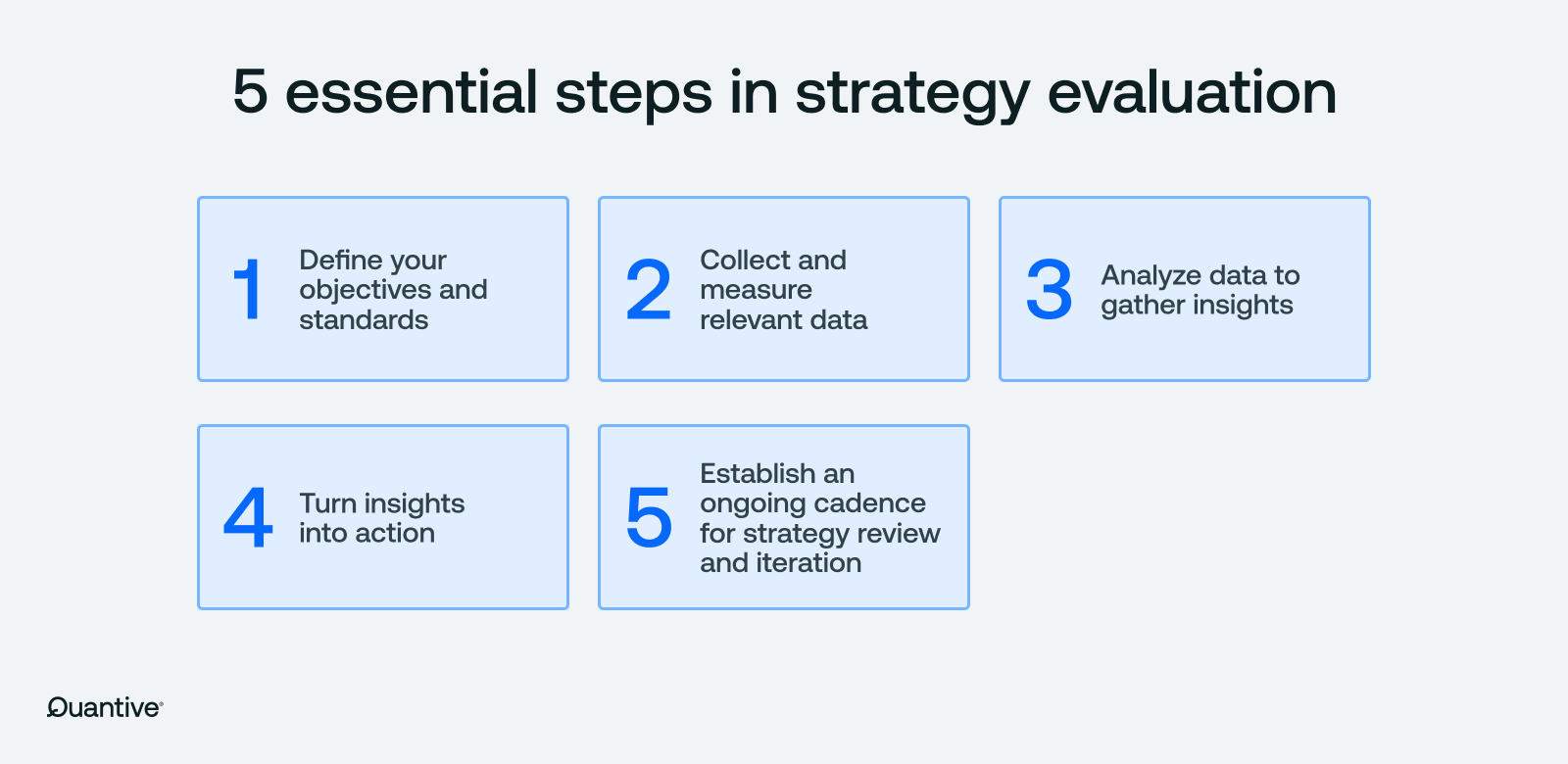Quantive is now part of WorkBoard. Get to know WorkBoard:
Picture this: You’ve got a solid strategy in motion. You’ve set clear goals, crafted a detailed action plan, and connected your teams to ensure they work together seamlessly. But as the months roll by and you move from quarter to quarter, you wonder if your strategy is truly bringing you closer to your goals.
Are your strategic initiatives delivering the results you hoped for?
Are your resources being used efficiently?
Is your strategy on track, driving steady progress?
The answers to these questions lie in strategy evaluation — a crucial, yet often overlooked, phase of strategy management.
Strategy evaluation is all about using real-time data to assess how effective your strategic efforts are, making sure you stay on course and are ready to pivot your strategy when needed.
If you’re looking to understand the ins and outs of strategy evaluation, you’re in the right place. This practical strategy evaluation guide will walk you through the five essential steps of strategy evaluation, offering best practices along the way.
But before we get into the steps, let’s take a look at what strategy evaluation is, why it’s important, and the benefits it brings.
What is strategy evaluation?
Strategy evaluation is the process by which a company reviews and assesses the effectiveness and efficiency of its strategic plan. It involves digging into metrics to see what’s working and what needs improvement in order to meet company goals. Strategy evaluation also entails reviewing internal and external environments to see what could possible hinder strategy implementation over the long run.
Why is strategy evaluation important?
Regularly checking in on your strategic performance keeps everyone in your business aligned with top priorities. Managed effectively, ongoing strategic evaluation ensures you’re always updated with the right information at the right time, allowing you to tweak your corporation's strategy and stay adaptive to market and business changes.
At Quantive, we believe this process should be an always-on activity. Continuous strategy evaluation helps you stay on top of key business performance metrics, ready to switch gears when needed.
Benefits of the strategy evaluation process
- Stay aligned with strategic goals: Make sure every initiative and workstream directly supports your company objectives, maintaining a unified focus toward common goals
- Adapt to change: Quickly respond to market shifts, capitalize on new opportunities, and tackle emerging threats head-on to keep your business flexible and competitive
- Optimize resource use: Maximize your resources, avoid duplicate efforts, and ensure investments drive optimal results
- Minimize risks and setbacks: Spot potential strategy issues early on and take corrective action before they escalate
- Improve decision-making: Use the latest data and insights to make informed and timely decisions that keep you ahead of market change

What are the 5 steps of strategy evaluation?
Now that we’ve covered the basics, let’s get practical.
Strategy evaluation, which is a critical part of the strategic management process, involves these five key steps:
- Define your objectives and standards
- Collect and measure relevant data
- Analyze data to gather insights
- Turn insights into action
- Establish an ongoing cadence for strategy review and iteration
We’ll cover each of these steps in detail below.

Step 1: Define your objectives and standards
The first step of strategy evaluation begins during strategy development, where you define what success means for your business. Clarifying your strategy’s key performance areas and success metrics early on helps you keep business efforts aligned with your strategic vision, setting a solid foundation for your strategy evaluation.
While the specific metrics you choose depend on what you’re trying to measure, the right goal measurement framework can make taking actionable steps toward achieving desired outcomes much smoother.
At Quantive, we recommend combining a robust goal management framework such as objectives and key results (OKRs) with key performance indicators (KPIs) for a comprehensive assessment of your strategy’s health.
Here’s why:
- OKRs provide a dynamic framework for setting ambitious and inspiring goals that push you out of your comfort zone and toward new heights
- KPIs offer precise, measurable benchmarks that track the effectiveness and efficiency of your initiatives
These frameworks are complementary: OKRs define your direction and vision of success, while KPIs measure progress toward these at every step of the way, ensuring you’re on the right track.
Read more on the complementary power of OKRs and KPIs

→Pro tip: Define and align both long-term and short-term objectives. Long-term objectives provide direction, while short-term goals keep the team focused and motivated.
Step 2: Collect and measure the right data
Once you’ve picked your metrics, the next step is to gather and keep track of the right numbers and feedback. This data gives you the real picture of your strategy, showing you what’s on track, what needs tweaking, and where things might be getting stuck.
Yet, collecting data for the sake of collecting data is pointless. Without clear intent, direction, and data reliability, you’ll end up wasting your time, energy, and resources.
You need to make sure your collected data is:
- Relevant: Tied directly to your strategic goals and objectives
- Unbiased: Free from biases that can skew the results
- Timely: Updated regularly so it reflects the current state of your strategy
To help you automatically gather, process, and analyze large volumes of data, you can rely on tools with lots of integrations and AI-assisted data connectivity. Not only do these ensure data accuracy, but they also help you analyze data in real-time while reducing the risk of human error.
Here are some additional tips for effective data collection:
- Assign ownership: Clarify who’s in charge of tracking what to ensure accountability and consistency while avoiding any gaps or overlaps
- Define cadence: Set a regular schedule for updating data so it’s always fresh, trustworthy, and reliable
- Centralize documentation: Keep all data updates in one place to make comparisons easy and reduce errors brought on by scattered information
→Pro tip: Stay updated on the latest privacy laws and regulations in the regions where you operate to keep your data collection practices compliant.
Step 3: Analyze data to gather insights
After you’ve collected your data, it’s time to dig in and find out what it’s telling you. This involves a few steps:
A) Comparing actual vs. projected results
Start by comparing your current performance metrics with your projected or desired results. This helps you spot where your strategy implementation process is hitting the mark and where it may be falling short.
B) Understanding the causes of successes and failures
Once you know what’s working and what isn’t, try to understand why. Go beyond surface-level metrics to uncover the real reasons behind your successes and failures.
For example, if sales have increased, figure out the root cause — was it a successful marketing campaign, product improvements, or favorable market conditions? Conversely, if performance is lacking, identify the specific challenges (e.g., product quality issues, tough competition, poor distribution channels) you need to tackle.
C) Analyzing performance metrics against benchmarks
Next, see how your results stack up against industry standards and competitor performance. Benchmarking provides valuable context and helps set realistic targets moving forward.
D) Pinpointing data trends and patterns
Look for trends and patterns in your data to predict future performance and uncover insights that aren’t immediately obvious. Tools like data visualization software and business intelligence platforms with AI guidance can help you easily find the insights you need, without needing to be data experts yourselves. They reveal trends and correlations (e.g., seasonal variations, common themes in customer complaints) that might not be immediately apparent.
E) Analyzing workstream and resource contributions to strategic progress
Assess whether your resources are allocated properly to support your strategy. Tools like Quantive Signals can help analyze the contribution of different workstreams and resources to your strategic progress. This allows you to see if resources are being used optimally and where adjustments might be needed.
F) Assessing the need for a strategic pivot
Finally, determine whether you need to refine your strategy. To do so, you can rely on tools and frameworks that clarify your current strategic position, identify areas for improvement, and evaluate the potential impacts of various strategic changes.
These tools and frameworks include:
- SWOT analysis: Identify your internal strengths and weaknesses, as well as external opportunities and threats
- GAP analysis: Compare your current performance with desired outcomes to identify discrepancies and areas for improvement
- PEST analysis: Evaluate external political, economic, social, and technological factors that can impact your business
- Scenario planning: Create and analyze various potential scenarios to understand how different strategies might perform under different conditions
→Pro tip: Use visual aids like charts and graphs to make data comparisons easier for your teams to understand. Modern strategy management solutions like Quantive StrategyAI not only provide these visuals but also uses AI to frame business insights and decisions within proven strategic frameworks. These support your teams by simplifying and fast-tracking informed decisions-making with greater confidence.
Step 4: Turn insights into action
Knowing what needs to change is one thing, but doing the work by making those changes is what keeps your strategy relevant.
Here’s how:
- Develop a detailed action plan with clear responsibilities and timelines, tying each step to specific metrics to track progress and measure success
- Update goals and metrics to reflect the new approach and make sure everyone is on the same page
- Implement the necessary changes
→Pro tip: Create a culture of accountability by setting up a clear and open reporting system. Get everyone on the team to regularly share updates on a common platform, so it’s easy to see who’s in charge of what and how things are progressing.
Step 5: Establish an ongoing cadence for strategy review and iteration
The final stage of strategy evaluation is an ongoing process that loops back to the first stage of strategy management: strategy development. This phase is all about setting up a system for continuous feedback to stay ahead of internal and external changes.
To nail this, schedule regular feedback and strategy review meetings (weekly or bi-weekly) to keep evaluation and iteration consistent. Each meeting should have a structured agenda to cover all important insights and feedback.
At Quantive, we call this cyclical approach to strategy management the “Always-On Strategy.” This approach, rooted in ongoing improvement, makes sure your plans are always adapting to new insights and changing conditions, keeping your business dynamic, responsive, and agile.
Discover the benefits of the Always-On Strategy

→Pro tip: After every meeting, send out a summary report highlighting key discussion points, decisions, and assigned action items. This creates a documented trail of decisions and progress while ensuring accountability, tracking, and alignment.
Criteria for evaluating your strategy
Tracking progress metrics is crucial, but a successful strategy goes beyond just seeing numbers grow. It's just as — if not more — important to evaluate how your strategy fits within the broader context of your environment.
Here are key criteria to consider during strategy evaluation:
- Internal consistency: Is the strategy formulation aligned with the company’s overall goals, policies, and objectives?
- Consistency with the environment: Does the strategy fit with external factors like economic, social, and technological trends?
- Advantage: Does the strategy give you a clear competitive advantage through unique resources, skills, or positioning?
- Feasibility: Is the strategy realistic and doable with the resources and capabilities you have?
- Workability: Can the strategy be implemented with practicality and ease?
- Degree of risk: What is the degree of risk involved in pursuing the strategy?
- Time horizon: Is the timeline for achieving your objectives appropriate?
- Magnitude of impact: What’s the potential impact of the strategy on the company and its stakeholders?
The wrap-up on strategy evaluation
This strategy evaluation guide reveals how crucial strategy evaluation is for keeping business-wide organizational strategies productive. Setting clear goals, collecting the right data, analyzing insights, and regularly reviewing progress and measuring organizational performance keeps your strategy results-driven and efficient.
However, the real value of evaluating your business strategy lies in the ability to provide actionable insights in line with market conditions. By constantly assessing your strategy and whether it suits your current environment, you can spot opportunities, identify areas for improvement, and stay aligned with your business goals.
Quantive StrategyAI can take your strategy evaluation process to the next level with features like real-time data analysis, performance tracking, and customizable data dashboards, giving you a birds-eye view of strategic performance. Moreover, its automated reports and adaptive nature makes navigating changes, optimizing resources, and implementing smart decisions a breeze.
Want to know more?
Check out the full features of Quantive StrategyAI here to see how it can make strategy evaluation a breeze.
Quantive empowers modern organizations to turn their ambitions into reality through strategic agility. It's where strategy, teams, and data come together to drive effective decision-making, streamline execution, and maximize performance.
As your company navigates today’s competitive landscape, you need an Always-On Strategy to continuously bridge the gap between current and desired business outcomes. Quantive brings together the technology, expertise, and passion to transform your strategy from a static plan to a feedback-driven engine for growth.
Whether you’re a visionary start-up, a mid-market business looking to conquer, or a large enterprise facing disruption, Quantive keeps you ahead — every step of the way. From OKR software to OKR consulting, we help you plan and meet your goals. For more information, visit www.quantive.com.





